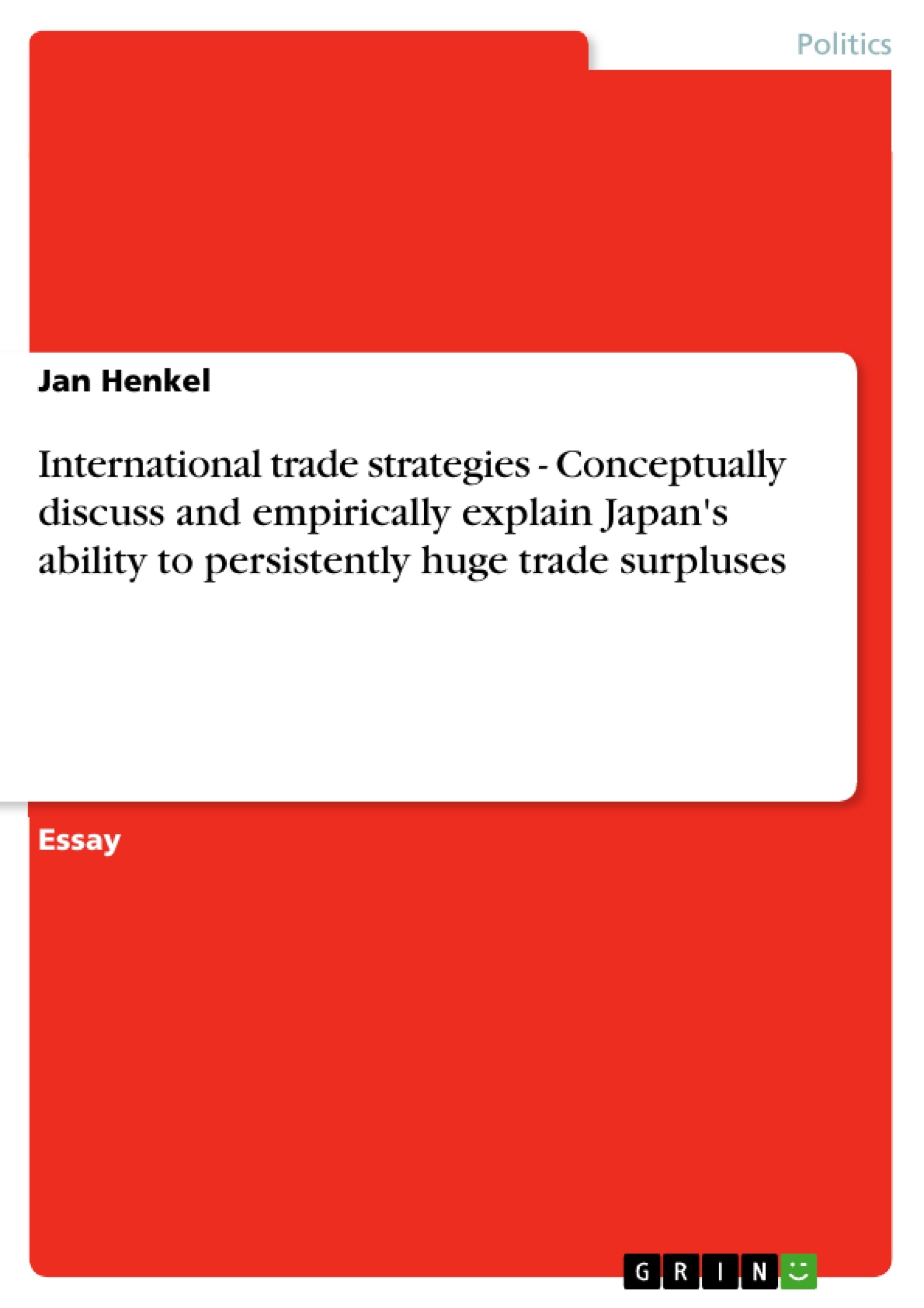Excerpt
I. Introduction
In the early 1950s “export or die” was a national slogan, which describes one strategy of the govenment to ensure economic growth in Japan.
This essay is dealing about international trade strategies in Japan after the second World War. The major goal of this work is to conceptually discuss and emprically explain how it was possible for Japan to sustain huge trade surpluses.
First of all it is necessary to define what is meant by trade surplus. A trade surplus exists when the balance-of-trade of a country is positive. That means that the extent of the value of merchandise exports has to exceed the value of merchandise imports (Levi: p. 589).
In general a country can achieve a trade surplus if it tries to maximize its exports and to minimize its imports.
The structure of my essay is followed by these two principles. Therefore a first part will deal with the exports of Japan, i.e. with the question how exports can be maximized. I will try to dicuss how exports have been promoted by MITI[1] and what further circumstances led to the significant growth of the export sector.
In a second part I am going to analyse the restrictions on imports. This chapter will include the explanation of tariff and non- tariff barriers as well as a discussion about the closed nature of the Japanese market.
But previous it is necessary to deal with the theoretical concepts. After that I am going to compare these with what happened in the Japanese reality so that I can finally summarize which factors have been the most influential to maintain the surplus of Japanese balance- of- trade.
1. Theoretical explanations
Several theories emphasize different items to explain why it was possible for Japan to sustain economic growth and huge surpluses in the balance- of- trade[2].
As I mentioned in the introduction a national slogan of the post- war period in Japan was “export or die”. This phrase is a quotation of the Japanese Prime Minister in those days. It is an expression of the so called “export led growth strategy” and shows that the government was going to focus its economic policy on exports, because they thought that this would be the only way to ensure that Japan will be a rich country. A successful export was seen as the basis of a strong economy.
Export- led growth is”usually characterized as a set of policies to induce growth in export industries” (Turner, p. 19). This statement connects the first theory- as I illustrated earlier- with a second one which focused on the close relationship between the bureaucracy, big business and government.
It is the so called “developmental state perspective” and that theory emphasizes the involvement of the government in general, or more specific the MITI, in the economy of Japan. Special industries were targeted and supported by govenment.[3] The goal was to earn the necessary technological knowhow to ensure economic growth by targeting special industries. This process has to be regulated by the Ministry of International Trade and Industry. The following quotation from an economic journal published by MITI shows that kind of thinking in those day: “Future growth will be sustained by modernization. We must adapt quickly to the everprogressing technology and environment of the world”(Ministry of Foreign Affairs Japan, p. 14).
Another conceptual explanation is the “creative defeat perspective”. The Japanese economic analyst Okita Saburo hits the nail squarely on the head, when he mentioned that Japan “has to concentrate on rebuilding its own economy and not become involved too much in others’ affairs” (Korhonen, p. 28). The principle of this strategy is to apply all national strength on reconstructing Japan’s economy after the capitulation in the second World War.
A further theory is the “free- market- perspective”. Advocates argue that economic growth was a result of a democratization of the economy pushed by the Americans. Three major reforms ensured the principle of a free market: the break-up of the Zaibtsus[4], land reform and labour democratization (Nakamura, p. 23ff).
The “neo marxist theory” emphasizes the support of Japan by the United States in the Cold War as shield against communism. Japanese analyst Kosai mentioned that the “ Japanese economy was also aided by the special procurements for the US military forces” (Korhonen, p. 39). Indirect and direct financial help from the US led to the economic growth in the post- war era.
The last theoretical explanation is called the “total factor productivity (TFP)”. The focus lies on the notion of productivitiy. Productivity is defined by dividing output through input. The higher the result the better is the economic efficiency of a country. Advocates argue that Japan had in those days a relatively high TFP, i.e. Japan had an efficient relation between in- and outputs.
Now after I have given an overview on the major theories, it is time to take a look at the empirically development of Japan’s economy so that I can analyse how correct these concepts have been in reality.
[...]
[1] Ministry of International Trade and Industry
[2] A list of Japanese balances-of- trade in the years from 1975-2003 is included in the appendix.
[3] You will find a more specific explanation of targeted and supported industries in the following
chapter.
[4] Zaibatsus are economic linkages between Japan’s major industrial groups (Prestowitz, p. 142).
Zaibatsus are large business trusts generally vertically organized through a number of indutries
and usually including their own financial arm (Ministry of Foreign Affairs Japan, p.9).
- Quote paper
- Diplom Volkswirt; M.A. Jan Henkel (Author), 2004, International trade strategies - Conceptually discuss and empirically explain Japan's ability to persistently huge trade surpluses, Munich, GRIN Verlag, https://www.grin.com/document/54930
Publish now - it's free






















Comments